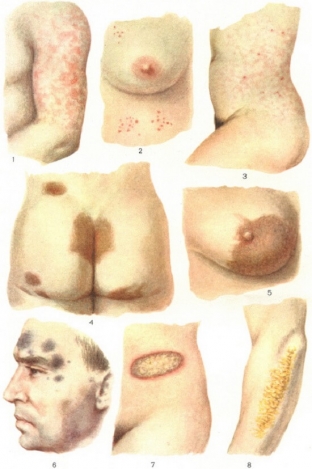Toxicoderma is the body's reaction to drugs or household chemicals. Read more about the causes of toxicoderma in our previous article. In most cases, the symptoms of toxicoderma occur acutely and are manifested by widespread symmetrical and monomorphic rashes. Rashes are represented by a variety of elements - from spots to knots. Symptoms of toxicoderma can also develop on the mucous membranes. Depending on the elements of rashes on the skin, several types of toxicoderma are distinguished. Clinical manifestations of types of toxicoderma know estet-portal.com.
What are the types of toxicoderma depending on clinical manifestations?
Abundant skin rashes, pronounced itching of the skin, the relationship of the recurrence of the disease with taking the drug – these are all symptoms of toxicoderma. Toxicoderma develops as a reaction of the body to chemicals, which are both medications and household chemicals. What drugs are more likely to provoke toxicoderma, read in the previous article on estet-portal.com. Depending on the elements of the rash, several types of toxicoderma are distinguished.
The main types of toxicoderma:
- roseolous;
- papular;
- knobby;
- vesicular;
- pustular;
- bullous.
Features of symptoms of toxicoderma in different forms of manifestation
Roseolous toxicoderma is characterized by an isolated arrangement of rash elements from each other, but the rash can merge with the subsequent formation of erythroderma. The rashes are ring-shaped, with their resolution, peeling is noted. The appearance of peeling in the center of the spot resembles the clinical picture of pink depriving Zhiber .
Papular toxicoderma is characterized by a disseminated lesion in the form of polygonal papules that resemble manifestations of lichen planus.
Knodular toxicoderma is manifested by the formation of painful nodes that have a vague outline and rise above the surface of the skin.
Symptoms of pustular toxicoderma often occur after taking iodine, bromine, fluorine and chlorine preparations. In the development of the elements of the rash, staphylococci play the role, which are activated under the influence of the above drugs.
Vesicular toxicoderma is characterized by rashes in the form of large vesicles with a narrow rim of hyperemia. There may be limited manifestations in the palms and soles in the form of dyshidrotic vesicles.
Symptoms of toxicoderma with bullous rash elements
 Bullous toxicoderma is divided into localized and widespread forms. The localized form is characterized by the presence of rounded spots. After a few days, they change color, first to cyanotic, then to brown. A bubble may form in the center of some spots.
Bullous toxicoderma is divided into localized and widespread forms. The localized form is characterized by the presence of rounded spots. After a few days, they change color, first to cyanotic, then to brown. A bubble may form in the center of some spots.
More often, localized toxicoderma affects the genitals and oral mucosa. When the drug that caused the symptoms of toxicoderma is discontinued, the manifestations of the bullous form stop.
The common form of bullous toxicoderma has similarities in clinical presentation with erythema multiforme exudative.
Common features of bullous toxicoderma and erythema multiforme exudative:
- unexpressed itching;
- presence of catarrhal phenomena;
- predominant lesion of the dorsum of the hands and feet;
- seasonality of recurrence in autumn and spring.
In addition to these symptoms of toxicoderma, there is an acute fulminant form that occurs according to the cytotoxic type. This is Lyell's syndrome, which is accompanied by epidermal necrosis, acanthosis and epidermolysis. The disease proceeds with an increase in temperature to high values and with severe intoxication.
Hemorrhagic spots form on the skin, which merge with each other. Then bubbles form, the epidermis detaches, and erosions form in place of the bubbles, which creates conditions for the infection to attach.
Identification of the symptoms of toxicoderma and the correct diagnosis guarantees effective treatment. Read more about the treatment of toxicoderma in our next article.







Add a comment